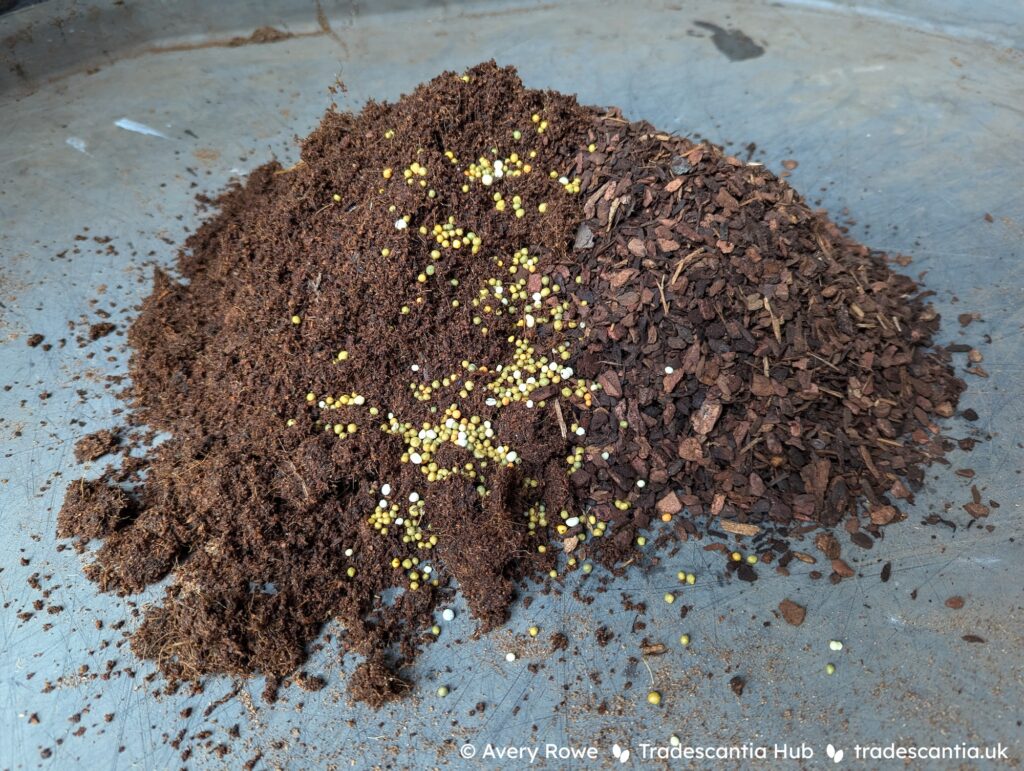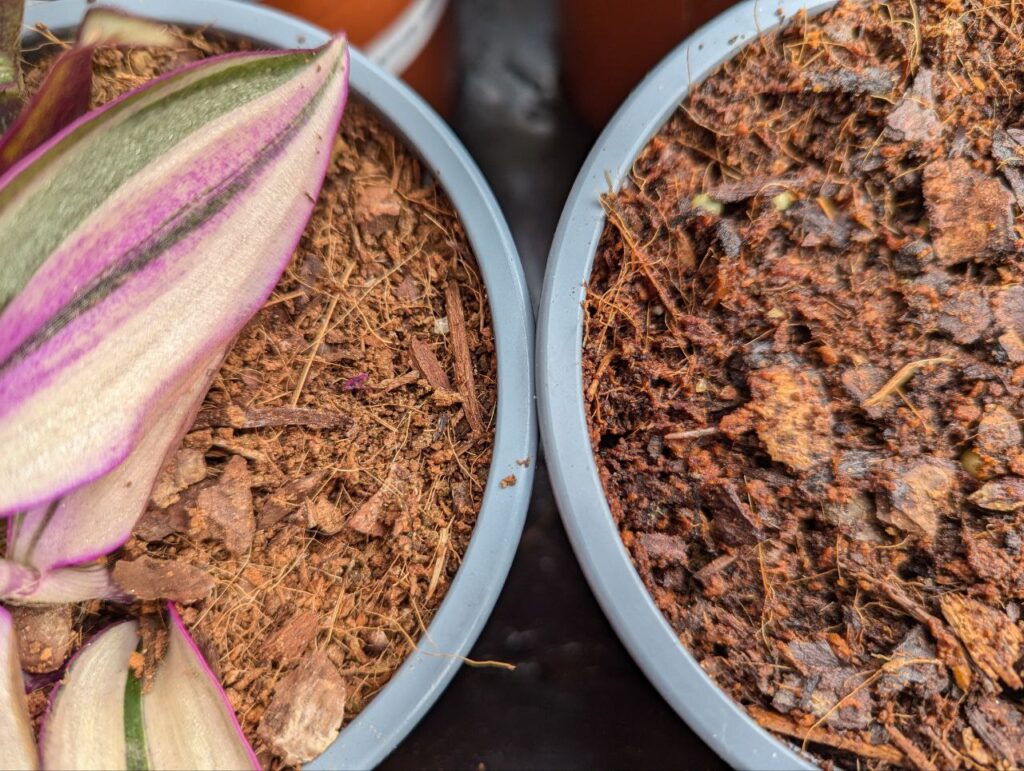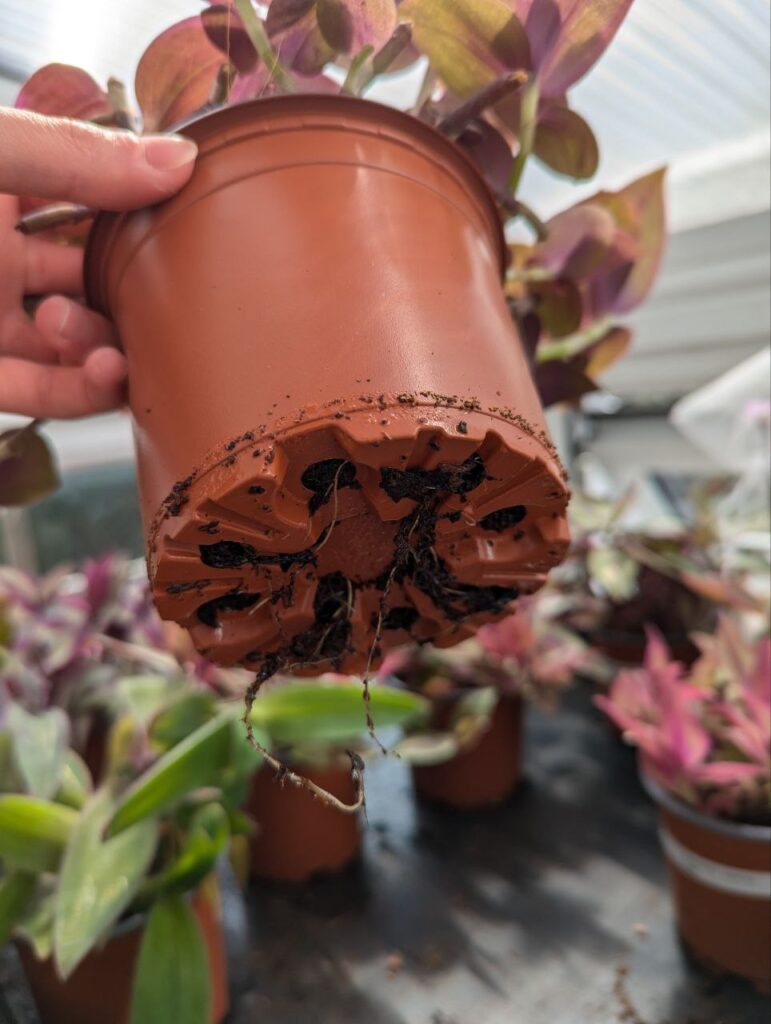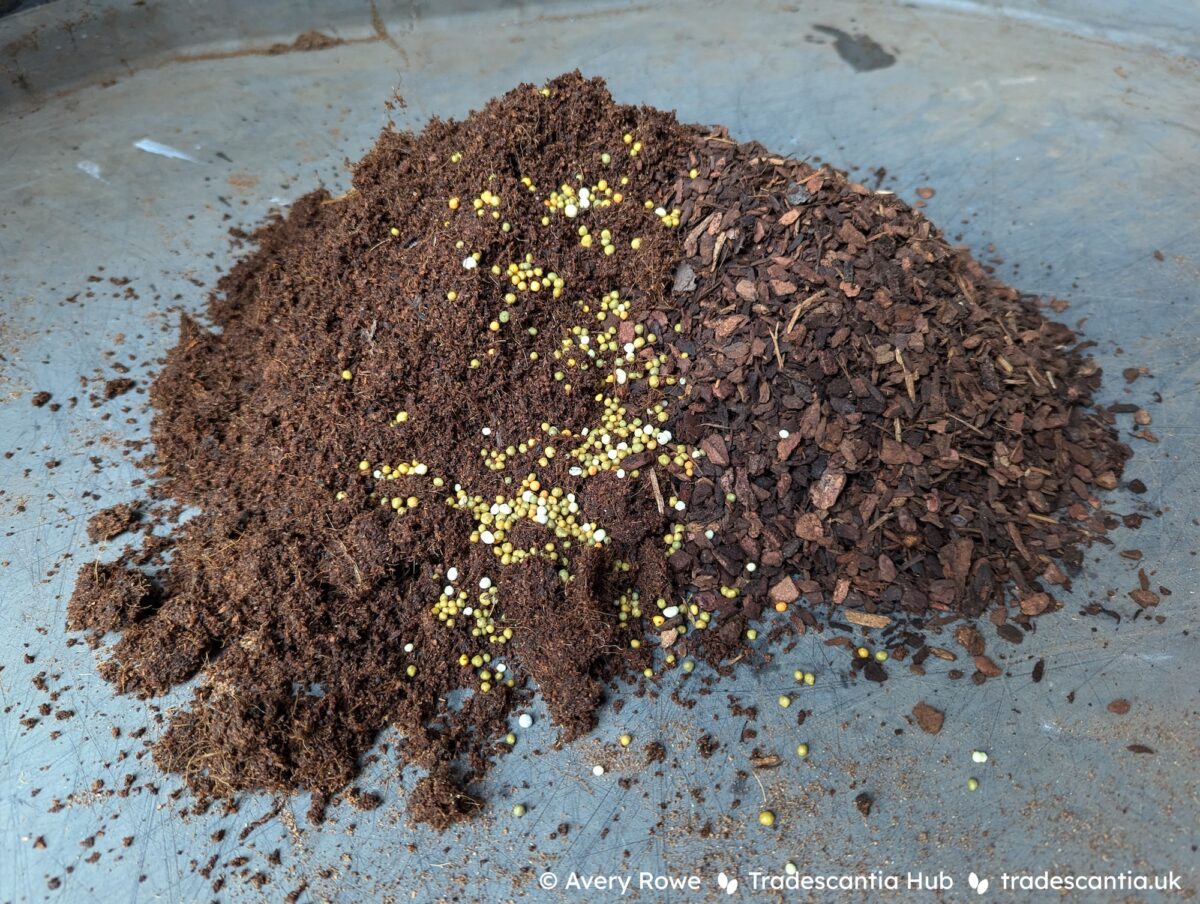Expand contents
- What is repotting?
- When is repotting necessary?
- When is repotting not necessary?
- The plant is rootbound
- It’s been X weeks/months/years since the plant was repotted
- The pot looks too big or too small for it
- The plant is falling over or falling out of the pot
- The plant is running out of nutrients
- The plant has pests
- The soil is wet or dry right now
- The plant got sunburn / a ripped leaf / frost damage / some other physical injury
- It will look better in this other pot
- Conclusions
Everyone knows repotting is an important part of long-term maintenance for plants. But sometimes people don’t fully realise why it’s important, or what impacts it can have. It’s quite common for houseplant enthusiasts to be overzealous about repotting, and end up doing it unnecessarily. And unfortunately, sometimes that instinct ends up making things worse for the plant. Repotting when it’s not needed will cause unnecessary stress to the plant, leading to slower growth and risking damage.
The only reason to repot a healthy plant is if the soil consistently dries out either too quickly or too slowly. In this article I’ll explain how to tell when a plant does (and doesn’t) need repotting, so you can make sure you give your plants the care they actually need. There’s quite a good chance that if you’re thinking of repotting, it’s actually not necessary at all!
What is repotting?
“Repotting” is a bit of a misleading word. It sounds like the important part of the process is re-potting: changing the pot the plant lives in. But the more significant aspect is changing the soil*.
(*Note: I’m using “soil” as a generic term to refer to whatever growing media, potting mix, or substrate the plant is in. I’ll get more specific about growing media later.)
Repotting a plant means removing it from its current container, removing some or all of the soil around its roots, then putting it back into a container and adding different soil. Sometimes that involves moving the plant to a different (often bigger) container, so there’s space for more soil overall. Other times it might stay in the same pot, or move to a smaller one.

When is repotting necessary?
Repotting is only necessary because container plants are living in such a constricted and artificial environment. Out in the wild, soil is contantly being recycled and refreshed and kept in balance. But in containers with a comparatively tiny quantity of potting mix, that natural balance can’t happen. So over time, what might have started out as the ideal environment for a container plant will eventually become unsuitable. We repot plants to reset their soil environment back to what they need.
In the wild, roots are rarely disturbed. They sit under the ground and generally go untouched for the whole life of the plant. So for a plant to have its roots exposed, moved around, and damaged is difficult. Even being repotted into an ideal situation is stressful, and can cause temporary damage or slowed growth to the plant.
For that reason, we should always try to avoid repotting or otherwise disturbing the roots. It is a last resort, only to be used when there’s no other way to solve the problem. And in truth, almost every problem has a solution other than repotting! Which brings us to…
The only good reason to repot a plant
A plant should only be repotted if it takes less than three days or more than a month to dry out between waterings, and it can’t be resolved by changing the growing conditions.
If you haven’t already, familiarise yourself with the golden rules of watering. At each watering, the soil should get fully saturated. Then it should be allowed to reach a certain level of dryness (the exact level depending on the plant in question), before being saturated again. That saturation-drying cycle provides the roots with balanced access to both air and water, and should take between three days and a month, for every plant. If it regularly takes longer or shorter than that, something else needs to change.

If the soil dries out too quickly
The soil needs to stay moist for long enough for the plant to drink its fill. If it dries out so quickly that it needs watering again after less than three days, the plant won’t be getting enough chance to actually absorb all the water it needs. Over time it will become chronically dehydrated, which will cause stunted growth, leaf loss, and – eventually – death.
The rate at which the soil dries out is dependent on many factors, some of them easier to control than others. It will sometimes be possible to solve the problem by decreasing the light level or temperature, or raising the humidity. But if those things can’t fix it, then it’s time to repot.
There are various different ways to slow down the drying cycle of a plant when repotting.
- Type of soil. The soil or growing medium itself is the main thing that defines the water retention. There are endless different potting mix options, and no single right answer. I can’t possibly cover everything here, but the two features which will increase water retention are:
- Using a higher proportion of materials that are absorbent. Common examples: coir, peat, vermiculite, compost.
- Having a smaller average particle size – fewer big chunks and more small crumbs in the mix.
- Amount of soil. How much water the soil holds is dependent on the amount of soil there is. So using a larger volume of soil – i.e., a larger container – will increase water retention. This is probably the most common approach when repotting.
- Type of pot. The container itself will also effect water retention, in various different ways.
- A “self-watering” pot with a reservoir will hold more water to begin with, and take longer to dry out.
- With the same soil volume, a wide shallow pot will initially hold more water than a tall deep pot.
- A pot made of a non-porous material like plastic or glazed ceramic will dry out slower than a terracotta pot.
- Root pruning. The more roots a plant has, the more water it absorbs. So you can slow the drying rate by pruning away some of the plant’s roots. This is a risky approach though, because having less roots also means the plant will struggle to sustain the same amount of leaves. In general if you’re pruning the roots you should prune away roughly the same proportion of the above-ground growth at the same time. This is how bonsai trees are kept in the same small container indefinitely.
You don’t need to change all of those things at once. In fact, it’s best not to, otherwise you risk going too far and having a container that stays waterlogged. Just one or two adjustments – a slightly larger pot, a bit more coir in the mix – will usually do the trick to get the drying cycle back into the ideal range.
If the soil dries out too slowly
The soil needs to start drying out within a reasonable time, and not stay waterlogged. If it’s wet for so long that it doesn’t need watering again after more than a month, the roots won’t be getting enough chance to breathe. Over time they’ll start to suffocate and rot away. That will lead to paradoxical dehydration in the plant, potential stem rot, and eventual death.
As with a container that dries too quickly, there are environmental changes that may solve the problem without repotting. Brighter light, lower humidity, or warmer temperatures will all speed up the rate of drying. (Don’t be tempted to water just a little bit at a time to fix this problem – remember the golden rules and always fully saturate the soil!) If environmental changes can’t solve the problem, then repotting is the only option.
There are several ways to speed up the drying cycle when repotting a plant. Most of them are the inverse of the suggestions in the previous section.
- Type of soil. The soil mix has the biggest affect on water retention. It’s impossible to describe all the potential choices, but there are two basic features that will decrease water retention:
- Using a higher proportion of materials that don’t absorb water internally. Common examples: perlite, grit.
- Having a larger average particle size – more big chunks and fewer small crumbs in the mix.
- Amount of soil. Less soil will hold less water. So moving a plant into a smaller container will speed up the drying rate.
- Type of pot. The container itself can be chosen to reduce water retention.
- With the same soil volume, a tall deep pot will hold less water than a wide shallow pot.
- A pot made of a porous material like terracotta will dry out faster than non-porous materials.
- More plants. This is the closest thing to the “opposite” of root pruning. More living roots in the pot will drink more water. So if you pot multiple plants together, or add extra cuttings or seedlings, together they will make the container dry out faster.
As above, don’t try to change all of these things at once. Choose one or two that seem the best for your situation and just change those. Then monitor the plant as it gets reestablished and make sure that the drying cycle is back on track.
When is repotting not necessary?
In short: almost any reason that wasn’t given above. There are rare exceptions, like infestation of root-specific pests, or contamination of the soil with something toxic. But in general, almost all the other justifications people give for repotting are inappropriate. I’ll cover the most common examples and explain why repotting isn’t automatically the right thing to do in these situations.

The plant is rootbound
“Rootbound” doesn’t have a precise definition, but it’s generally used when the roots are circling around the bottom of the pot or growing out of the drainage holes. Often people assume this means that the plant must need repotting, but that’s not the case!
As the pot becomes more filled with roots, the soil tends dry out more quickly. But the plant only needs repotting if it’s drying out within less than three days. Some tough plants can have a pot full of roots and still last a week or two between waterings. Others might have a small shallow root system but still be drying out too fast. And visible roots at the drainage holes don’t necessarily mean the pot is full of roots anyway – they tend to grow out of openings even while there is still plenty of soil available in the pot.
Visible roots can be a hint about how the plant is doing, but they are not a guarantee. Only monitoring the actual moisture of the soil and how it changes over time will tell you whether repotting is necessary.
It’s been X weeks/months/years since the plant was repotted
Just like seeing roots come out of the pot, this is commonly used as a way to decide when to repot a plant. People sometimes recommend that every houseplant should be repotted once a year (or some other arbitrary amount of time). That rule doesn’t reflect the reality of what plants need.
A fast-growing, water-hungry plant might start to dry out too quickly within weeks or months of being repotted. A cactus might maintain an ideal drying cycle in the same pot for decades. The only way to know whether your specific plant needs repotting is to monitor its water use, and see whether it’s taking the right amount of time to dry between waterings.
The pot looks too big or too small for it
This is another common justification. But just like the first two, it misses the point. A plant can be perfectly healthy in a large pot if it requires a lot of water and is growing in a hot dry environment. Equally, a plant can do fine in a small pot if it has low water needs and the surroundings are cool or humid.
Once again, the important thing is the saturation-drying cycle. Does the plant take between three days and a month to dry out between waterings? Yes? Then it’s fine! It doesn’t matter whether the pot looks too big or small, it only matters whether the soil is actually drying out at the correct rate.
The plant is falling over or falling out of the pot
Sometimes this happens with tall upright trees, or long trailing plants. Repotting with denser soil and a wider, heavier pot might help the roots keep a better grip. But the trauma of repotting will make the problem even worse in the short term, and it’s not usually worth it.
Instead, use external support to reduce the force that’s pulling the roots out of the pot. For tall trees, give them a stake or trellis to lean against, and consider pruning tall or lopsided stems. For trailing plants, prune the long heavy parts or rest them on a surface so their weight isn’t hanging from the roots.
The plant is running out of nutrients
Most potting soils have a source of nutrients included. After a while, those nutrients will be depleted and plants will start to get hungry – showing slowed growth and often yellowing leaves. Repotting with fresh nutrient-rich soil will solve this, but there are much easier ways.
You can top-dress the container, sprinkling slow-release fertiliser pellets or rich compost onto the surface, which will allow the nutrients to gradually soak down to the roots. Or you can apply liquid fertiliser every few waterings, which will give the roots instant access. You can even spray fertiliser onto the leaves to be absorbed directly. These methods will all take effect more quickly than repotting, because the plant doesn’t have to recover from stress and root damage before it can make use of the nutrients.
The plant has pests
All the most common houseplant pests live on the leaves and stems above the soil – thrips, mealybugs, aphids, scale, spidermites. These pests can all be effectively treated without removing the plant from its pot by using contact killers, systemic pesticides, or biological controls.
Only less-common pests like root mealybugs and vine weevil grubs will attack the roots from below the soil. You won’t see these pests on the above-ground parts of the plant at all, and they’re often only spotted when repotting for some other reason. In those exceptional cases, changing the soil is a useful step for treatment.
But don’t rush to repot just because you saw pests on the leaves. The trauma of disturbing the roots will only make the plant less able to withstand and recover from pest damage.
The soil is wet or dry right now
Check the golden rules for watering again! Overwatering and underwatering are chronic conditions. If you bought a new plant, or you just watered a plant, and now the soil is wet – that’s fine. If you forgot to water for a while and now the soil is very dry, that’s fine too.
Saturate the soil if it needs watering. Then monitor it as it dries out, and see how long it takes to reach the right dryness to water again. If it takes less than three days, or more than a month, then it might need repotting to adjust the timing of that cycle.
The plant got sunburn / a ripped leaf / frost damage / some other physical injury
Repotting won’t help any of these things. In fact, it will almost certainly make matters worse. When a plant is injured, it just needs stable, comfortable conditions to recover. Ripping its roots out of the soil and throwing its water and nutrient balances out of whack will not help!
Imagine if you broke your arm – would being forced to move house help you to heal? You’d probably rather just have some peace and quiet to rest comfortably. It’s the same for an injured plant. Keep watering it properly and give it the best environmental conditions you can, and let it recover in its own time.
Conclusions
Repotting is an important part of long-term maintenance for any container plant. It’s also a stressful process for a plant to go through. So keeping container plants healthy ideally means repotting when they need it, and only when they need it.
The only reason that a healthy plant needs repotting is if the soil consistently takes less than three days, or more than a month, to dry out in between waterings. If you’re thinking of repotting, make sure you understand why you’re doing it and what’s likely to happen. A lot of the time it’s probably not necessary at all!
But ultimately, we grow plants for ourselves. If you really just want to repot a plant for some reason – even though it’s not strictly necessary – that’s your choice. When you understand what repotting does and how it affects a plant, you can make an informed decision and be prepared for the outcome. Even if that means repotting “unnecessarily” just because you want to move it into a pretty container, and accepting the risk that the plant will be stressed for a while.


One reply on “When (not) to repot a plant”
Thank you for all of this information. I appreciate the time it took for you to write the article.